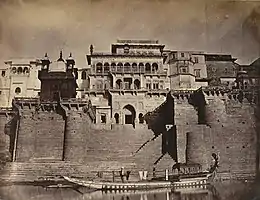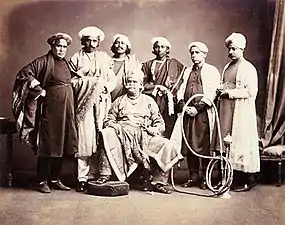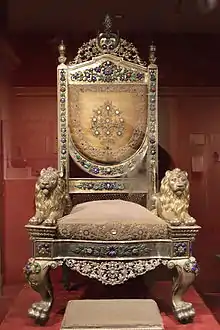Benares State
Benares or Banaras State was a princely state in what is today India during the British Raj. On 15 October 1948 Benares' last ruler signed the accession to the Indian Union.[1]
Benares State | |||||||||||
|---|---|---|---|---|---|---|---|---|---|---|---|
| 1740–1948 | |||||||||||
 Flag
 Coat of arms
| |||||||||||
 Benares State in the Imperial Gazetteer of India | |||||||||||
| Capital | Benares (Kashi) | ||||||||||
| Religion | Hinduism (official) | ||||||||||
| Maharaja Bahadur | |||||||||||
| History | |||||||||||
• Established | 1740 | ||||||||||
| 1948 | |||||||||||
| Area | |||||||||||
| 1892 | 2,266 km2 (875 sq mi) | ||||||||||
| Population | |||||||||||
• 1892 | 115,773 | ||||||||||
| |||||||||||
| Today part of | |||||||||||



The state was founded by the local zamindar, Raja Balwant Singh, who assumed the title of "Raja of Benares" in mid 18th century, taking advantage of the Mughal Empire's disintegration. His descendants ruled the area around Benares as feudatories of Nawab of Awadh and East India Company. In 1910, Benares became a full-fledged state of British India.[2] The state was merged in India after India's independence in 1947, but even today the Kashi Naresh (the titular ruler) is deeply revered by the people of Varanasi. He is a religious leader and the people of Varanasi consider him an incarnation of Shiva.[3] He is also the chief cultural patron and an essential part of all religious celebrations.[3] The ruling family claims descent from the God Shiva and benefits greatly from pilgrimages to Benares. In 1948 the 88th ruler of Kashi Sir Vibhuti Narayan Singh accepted the request of the first Indian Prime minister Jawaharlal Nehru and signed the accession to the Indian Union.[4]
History
Princely State
The earliest rulers of the later princely state of Benares were zamindars for the Awadh (Oudh) province of the Mughal Empire. Most of the area currently known as Varanasi was acquired by Mansa Ram, a zamindar of Utaria. Balwant Singh, the ruler of Utaria in 1737,took over the Jagirs of Jaunpur (except Bayalasi which was ruled independently by Zamindar of Purenw), Varanasi, and Chunar, in 1737 from the Mughal Emperor Muhammad Shah of Delhi .The Kingdom of Benaras started in this way during the Mughal dynasty. Other places under the kingship of Kashi Naresh were Chandauli, Gyanpur, Chakia, Latifshah, Mirzapur, Nandeshwar, Mint House and Vindhyachal. With the decline of the Mughal Empire, the Bhumihar Brahmins under the leadership of Kashi Naresh strengthened their sway in the area south of Avadh and in the fertile rice growing areas of Benares, Jaunpur, Gorakhpur, Basti, Deoria, Azamgarh, Ghazipur, Ballia and Bihar and on the fringes of Bengal[5] As the Mughal suzerainty weakened, the Benares zamindari estate became Banaras State, thus Balwant Singh of the Narayan dynasty regained control of the territories and declared himself Maharaja of Benares in 1740.[6] The strong clan organisation on which they rested, brought success to the lesser known Hindu princes.[5] There were as many as 100,000 men backing the power of the Benares rajas in what later became the districts of Benares, Gorakhpur and Azamgarh.[5] This proved a decisive advantage when the dynasty faced a rival and the nominal suzerain, the Nawab of Oudh, in the 1750s and the 1760s.[5] An exhausting guerrilla war, waged by the Benares ruler against the Oudh camp, using his troops, forced the Nawab to withdraw his main force.[5] The region eventually ceded by the Nawab of Oudh to the Company Rule in India in 1775, who recognized Benares as a family dominion. Benares became a princely state in 1911.[7] It was given the privilege of the 13-gun salute.

History of Ramnagar
The residential palace of the Naresh is the Ramnagar Fort at Ramnagar near Varanasi, which is next to the river Ganges.[8]
The Ramnagar Fort was built by Raja Balwant Singh with creamy chunar sandstone in the eighteenth century. It is a typically Mughal style of architecture with carved balconies, open courtyards, and picturesque pavilions.[3]
Kashi Naresh donated over 1,300 acres (5.3 km2) of land on the outskirts of the city to build the campus of Banaras Hindu University.
On 28 January 1983, the Kashi Vishwanath Temple was taken over by the government of Uttar Pradesh and its management was transferred to a trust, with the late Vibhuti Narayan Singh, then Kashi Naresh, as President, and an executive committee with the Divisional Commissioner as Chairman.[9]
Ram Leela at Ramnagar
When the Dussehra festivities are inaugurated with a colourful pageant, the Kashi Naresh rides an elephant at the head of the procession. Then, resplendent in silk and brocade, he inaugurates the month-long folk theatre of Ramlila at Ramnagar.[10]
The Ramlila is a cycle of plays which recounts the epic story of Lord Rama, as told in Ramcharitmanas, the version of the Ramayana written by Tulsidas. The plays, sponsored by the Maharaja, are performed in Ramnagar every evening for 31 days. On the last day the festivities reach a crescendo as Rama vanquishes the demon king Ravana. Maharaja Udit Narayan Singh started this tradition of staging the Ramleela at Ramnagar in the mid-nineteenth century.[10]
Over a million pilgrims arrive annually for the vast processions and performances organized by the Kashi Naresh.[11]
Geography
From 1737, the state included most of present-day Bhadohi, Chandauli, Jaunpur, Mirzapur, Sonbhadra, and Varanasi districts, including the city of Varanasi. Balwant Singh expelled Fazl Ali from present-day Ghazipur and Ballia, and added it to his domains.[12]
Between 1775 and 1795, the British gradually took over administration of most of the state, leaving the rajas to directly administer two separate areas – an eastern portion, corresponding to present-day Bhadohi district, and a southern portion, comprising present-day Chakia tehsil of Chandauli district. These two areas made up the princely state of Benares from 1911 to 1948. The rajas retained certain revenues from rents, and certain administrative rights, in the rest of the territory, which the British administered as Benares Division, part of the United Provinces. The rajas made their main residence in Ramnagar.
All India Kashi Raj Trust
Serious work on the Puranas began when the All India Kashiraj Trust was formed under the patronage and guidance of Dr. Vibhuti Narayan Singh, the Maharaja of Kashi, which, in addition to producing critical editions of the Puranas, also published the journal Puranam.[13]
Saraswati Bhawan at Ramnagar Fort
A rare collection of manuscripts, especially religious writings, is housed in Saraswati Bhawan. It includes a precious handwritten manuscript by Goswami Tulsidas. There are also many books illustrated in the Mughal miniature style, with beautifully designed covers.[14]
Vyasa Temple at Ramnagar
Vyasa Kasi, the name by which the temple is called by the people on pilgrimage to Kasi, through ages, is located near Ramnagar. A temple for Sage Vyasa is located here facing Kasi on the opposite side of the river Ganga. The temple is at a distance of 19 km by road from Kasi. Once upon a time the whole area was covered by a forest of Badari trees. ( Badari is called 'Bel’ or ‘ber’ in Hindi and 'Jujube’ in English). Badari is a thorny bush- like tree which gives small sweet and sour fruits. Since Vyasa lived among the Badari trees, he was also called ‘Baadarayana’ (a person who moved among the badari bushes). People who go on pilgrimage to Kasi does not fail to visit Vyasa Kasi. They travel through boats that ply on the river Ganga. But when once they reach Vyasa-Kasi, they finish their tour of the place very quickly and return to Kasi before Sunset. Nobody makes a night halt at this place.
Sage Vyasa,who had to live in this forest along with his disciples some 2000–2500 years ago, is also called by other names such as – Veda Vyasa, Krishna Dwaipayana, Paarasarya (son of Rishi Parasara) and Satyavateya (son of mother Satyavati). He had to live there as he was banished from the city of Kasi by Lord Viswanath, the reigning deity of Kasi.According to a popular Puranic story, when Vyasa failed to receive alms in Varanasi, he put a curse on the city.[14] Soon after, at a house where Parvati and Shiva had taken human form as householders, Vyasa was so pleased with the alms he received that he forgot his curse. However, because of Vyasa's bad temper Shiva banished him from Varanasi. Resolving to remain nearby, Vyasa took up residence on the other side of the Ganges, where his temple may still be seen at Ramnagar.[14]
Rulers
The rulers of the state carried the title "Maharaja Bahadur" from 1859 onwards.
Zamindar
- 1737–1740 Mansa Ram (d.1740)
Rajas
- 1740 – 19 Aug 1770 Balwant Singh (b. 1711 – d. 1770)
- 19 Aug 1770 – 14 Sep 1781 Chait Singh (b. 17.. – d. 1810)
- 14 Sep 1781 – 12 Sep 1795 Mahipat Narayan Singh (b. 1756 – d. 1795)
- 12 Sep 1795 – 4 Apr 1835 Udit Narayan Singh (b. 1778 – d. 1835)
- 4 Apr 1835 – 13 Jun 1889 Ishvari Prasad Narayan Singh (b. 1822 – d. 1889) (personal style Maharaja Bahadur from 11 Aug 1859) (from 1 Jan 1877, Sir Ishvari Prasad Narayan Singh)
- 13 Jun 1889 – 1 Apr 1911 Prabhu Narayan Singh (b. 1855 – d. 1931) (personal style Maharaja Bahadur from 23 Sep 1889) (from 1 Jan 1891, Sir Prabhu Narayan Singh)
Maharaja Bahadurs
- 1 Apr 1911 – 4 Aug 1931 Sir Prabhu Narayan Singh (b. 1855 – d. 1931)
- 4 Aug 1931 – 5 Apr 1939 Aditya Narayan Singh (b. 1874 – d. 1939) (from 3 Jun 1933, Sir Aditya Narayan Singh)
- 5 Apr 1939 – 15 Aug 1947 Vibhuti Narayan Singh (b. 1927 – d. 2000)
See also
References
- "Benares Princely State". Archived from the original on 8 June 2017. Retrieved 18 June 2014.
- Swati Mitra 2002, pp. 124–126.
- Swati Mitra 2002, p. 216.
- "Benares Princely State". Archived from the original on 8 June 2017. Retrieved 18 June 2014.
- Bayly, Christopher Alan (1983). Rulers, Townsmen, and Bazaars: North Indian Society in the Age of British Expansion, 1770–1870. Cambridge University Press. p. 489 (at p 18). ISBN 978-0-521-31054-3.
- Bayly, C. A. (19 May 1988). Rulers, Townsmen and Bazaars: North Indian Society in the Age of British Expansion, 1770–1870. CUP Archive. pp. 17–. ISBN 978-0-521-31054-3.
- Benares (Princely State) Archived 21 February 2006 at the Wayback Machine – A Document about Maharajas of Varanasi
- "A review of Varanasi". Archived from the original on 24 September 2009. Retrieved 16 August 2006.
- "Official website of Varanasi". Archived from the original on 10 February 2007. Retrieved 16 August 2006.
- Swati Mitra 2002, p. 126.
- Banham, Martin (1995). The Cambridge Guide to Theatre (second ed.). Cambridge University Press. pp. 1247. ISBN 978-0-521-43437-9.
- "Ghazipur District", Imperial Gazetteer of India, Oxford, Clarendon Press, 1908–1931. v. 12, p. 224.
- Mittal, Sushil (2004). The Hindu World. Routledge. pp. 657. ISBN 978-0-415-21527-5.
- Swati Mitra 2002, p. 129.
Bibliography
- Swati Mitra (2002). Good Earth Varanasi city guide. Eicher Goodearth. ISBN 978-81-87780-04-5.
External links
 Media related to Benares State at Wikimedia Commons
Media related to Benares State at Wikimedia Commons